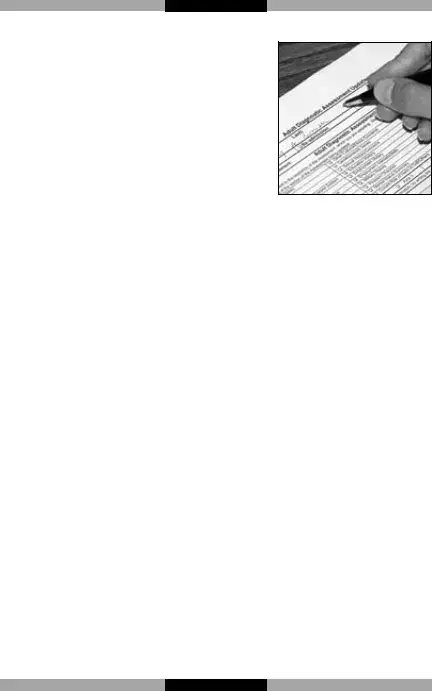Getting Started with
S O Q I C
A new standard in documentation
An Introduction to the
SOQIC Standardized
Documentation System
Solutions for Ohio’s Quality Improvement and Compliance
For more information about the Solutions for Ohio’s Quality Improvement and Compliance initiative, please contact:
Ohio Department of Mental Health Racquel Graham
Community Mental Health Program Manager 30 East Broad Street, 8th floor
Columbus, Ohio 43215-3430
(614) 728-9784
http://www.mh.state.oh.us/cmtymh/soqic/soqic.index.html
“Re-engineering clinical processes and documen- tation has become an ur- gent priority in behavioral healthcare. The require- ments of funders and regu- lators continue to evolve, and in too many cases record systems just expand to cover new requirements. Clinicians spend more time on paperwork than on pro- viding care. SOQIC attacks that problem, and even more critically, strengthens consumer participation in treatment.”
- Michael F. Hogan, Ph.D., Director, ODMH
“As ODMH and ODADAS continue to streamline the ‘red tape’ commonly ex- pected with state-funded services, Ohio citizens will reap the benefits of en- hanced mental health and addiction treatment.”
- Gary Q. Tester, Director, ODADAS
What is SOQIC?
Solutions for Ohio’s Quality Improvement and Compliance (SOQIC) is a collaborative venture between the Ohio Department of Mental Health (ODMH), the Ohio Department of Alcohol and Drug Addiction Services (ODADAS), mental health boards, providers and clients. The primary objective was to design, develop and implement at the State, Board and local provider levels a standard- ized consumer-centered, compliant and cost- effective mental health delivery system.
Individual mental health provider agencies in different regions of Ohio have traditionally established very diverse types of forms and processes to collect clinical and non-clinical information. While this opportunity to estab- lish agency-specific documentation helps to meet the individual documentation needs of each organization, it has also led to examples of redundancy, inefficiency, non-compliance, and an inability to compare useful data among agencies throughout the system.
The SOQIC standardized documentation system provides standardized, integrated clinical forms with enhanced compliance and quality for Ohio’s public mental health system. The forms cover the entire treatment process from demographic information to transfer/discharge, including assessment, treatment planning and progress notes. All are designed to accommodate the various
certification, national accreditation and Medicare/Medicaid compliance requirements, as well as all ODMH and ODADAS rules and standards.
What are the benefits of SOQIC?
There are many benefits to implementing an inte- grated documentation system. The SOQIC forms:
•Provide an integrated documentation system for mental health and alcohol and drug treatment.
•Promote recovery, actively engaging clients in their treatment process.
•Simplify paperwork
•Reduce redundancy for clients.
•Prompt ensure completeness of documentation.
•Provide for quick and easy record updating.
•Provide checkboxes and fill-ins that simplify documentation.
•Improve clinical practice
•Forms are comprehensive and provide prompts.
•Link diagnostic assessment and identified treatment needs to goals and objectives.
•Link progress notes to specific goals and objectives.
•Are compliant with all regulations and accreditation standards:
•ODMH and ODADAS
•Medicare/Medicaid
•JCAHO, COA, CARF
•Save time
•Reduce redundant assessment processes.
•Promote same day or concurrent documentation.
However, the benefits of the SOQIC documentation system are best expressed by clinicians, consumers and family members who have experienced the forms:
Enhances clinical care
“I think healthcare providers didn’t go into healthcare to document what they’re doing. They went into healthcare to take care of people. So, anything that can allow all of us providers, be it physicians, be it nurses, be it therapists, be it community support specialists, to be able to do our job better and provide
What are the benefits of SOQIC?
service for our patients and clients is just – is a tremendous advantage,” said Hilton J. Rodriguez, M.D., Medical Director, Eastway Behavioral Healthcare.
Provides a client-centered Recovery/Resiliency focus
“Client participation is probably the most important aspect of treatment because I don’t think the treatment works without the client’s input, knowing where they are and where they need to go,” said Sherry Gibson, Board Chair of the Ohio Federation for Children’s Mental Health. “And what I see in the SOQIC forms, there’s an appearance of that interaction, and that extracting of the client’s perspective on what their needs are and what their goals and objectives should be.”
“I believe the SOQIC forms will be beneficial to the consumer because the forms themselves solicit the opinions and the wants, the desires, the needs of the client, which then can be taken into consideration as the clinician develops their recommendations and their plans for treatment. Because the plan is developed, not just by the clinician, but by the clinician with the consumer,” said Dan Carpenetti, MED, LPCC, Clinical Director, Cambridge Office of Thompkins Child and Adolescent Services.
Enhances measurement and duplication of positive outcomes
“Clients will have better outcomes because they are calling the steps. They’re investing in their own treatment. [SOQIC forms]will also help to keep clinicians focused on working together for a specific outcome,” said Gibson.
Enhances accessibility to services
“One of the side benefits of SOQIC is that each agency or each provider won’t have to reinvent the wheel every time, and come up with their own documenta- tion or their own intake process and intake forms and some of the program development pieces. Since there would be a uniformity of practice to some degree and a uniformity of documentation, it will offer providers opportunities to provide more care as opposed to spending time developing the forms and practices around administrative issues,” said Jonas Thom, Director, Ohio Coordinating Center for Assertive Community Treatment.
What are the benefits of SOQIC?
Enhances cost efficiency
“And it’s also been a real tool for us when we’re hiring staff who don’t have a background or are new to the field, new to working in community mental health,” said Stephan Young, CEO, Forensic and Mental Health Services, Inc. “The tools really are assets in training staff so you can walk them through. This is what needs to be done clinically and the forms support that. So, it just reinforces the learning. So, we found it makes it a lot easier to train staff.”
Meets certification and national accreditation compliance guidelines
“…if we put all of these forms in place, we will have met all of the regulations we need to meet CARF and ODMH and ODADAS, and all of the regulation agencies….the way it is now, we just run around saying, ‘have we done it, have
we done it?’ And that way we’ll know, if we put these forms in place, that we’ll have met those,” said Linda Miller, Director of Severe Mentally Disabled Services and Nursing Supervisor, The Center for Individual and Family Ser- vices.
Reduces use of multiple forms/processes statewide
“Frequently, administrators don’t understand that one more little piece of paper just creates much more stress. I mean, there are straws that do break camels’ backs,” said Veronica Groff, President and CEO, The Center for Individual and Family Services. “And so it’s our philosophy here not to do that and I think SOQIC is going to help us do that.”
Provides more objective reviews/audits
“We had a Medicaid audit last summer where the auditors came in and could see the old forms versus the SOQIC forms, and had indicated that they saw a lot of improvement in terms of what was being documented and the compli- ance with Medicaid issues,” said Gail Carmon, Associate Director, Alternative Paths, Inc.
Provides a reduced compliance risk environment
“The forms allow you to be compliant,” said Ferens. “And in this day and age, yes, clinical care is the utmost, most important thing, but you can’t provide clinical care if you’re not in compliance. The forms allow you to do that.”
How can we access the forms?
SOQIC forms are available in both electronic and paper formats.
Electronic Forms
The electronic forms, or e-forms, are designed to download, complete and save on the user’s desktop or in the user’s system. The forms were developed in Pure-Edge Forms Designer software and are provided to agencies at no cost along with a Pure-Edge reader, which enables the use of the forms.
Features of the e-forms include expandable text fields, auto-fill some fields, check boxes, drop-down boxes, and others that enable easy navigation through the forms. Initial feedback from the pilot agencies indicates that clinicians like the forms and their ease of use very much.
While these forms do not come with a database, ODMH is working with Pure- Edge to make the forms available with a XML (Extensible Markup Language) data model component that will enable organizations to, with XML parser tools, extract the data from the forms and import it to their database. Some software vendors are incorporating the SOQIC forms in the systems that providers currently use.
Paper Forms
The paper forms and manual are currently available on the SOQIC Web site at http://www.mh.state.oh.us/initiatives/soqic/soqic.home.html and are also available on CD-Rom by request. The paper forms are designed to be down- loaded, printed and completed by hand.
What forms are available?
Twenty-two forms covering the full range of the treatment process are avail- able. Five additional forms for drug and alcohol treatment are also available. All are designed to accommodate the various certification, national accreditation and Medicare/Medicaid compliance requirements, as well as all ODMH and ODADAS rules and standards.
The SOQIC forms include:
•Demographic Information
•Health History Questionnaire
•Crisis Intervention Assessment and Plan
•Adult Diagnosis Assessment
•Adult Diagnosis Assessment Update
•Child/Adolescent Diagnostic Assessment
•Child/Adolescent Diagnostic Assessment Update
•Mental Status Exam
•Lethality Assessment
•Initial Psychiatric Evaluation
•Individualized Service Plan
•Individualized Service Plan Revision/Review
•Psychiatric/Pharmacological Management Plan
•Medical Somatic/Psychiatric Progress Note
•Medical Somatic/Nursing Progress Note Long
•Medical Somatic/Nursing Progress Note Short
•Individual Progress Note
•Community Psychiatric Supportive Treatment Progress Note Long
•Community Psychiatric Supportive Treatment Progress Note Short
•Group Progress Note
•Partial Hospital Progress Note
•Transfer/Discharge Summary
The ODADAS forms include:
•AoD Activity Education Note
•AoD Adult LOC Criteria
•AoD Adult Recommendations
•AoD Youth LOC Criteria
•AoD Youth Recommendations
Should we adopt SOQIC?
As you begin to consider implementing the SOQIC forms in your organization, it is useful to ask the questions below. To successfully implement an innovative practice, there are three phases to consider:
Initiation phase: Learning, evaluating
Decision: Go/No go
Implementation: Developing plans for moving forward
Initiation phase
•Do we understand what SOQIC is and what the benefits are?
•What are the Pros/Cons of adopting SOQIC?
•Why should we institute this new documentation system in our organization? What advantages do we see in implementing SOQIC?
•What risks can we anticipate in adopting or not adopting SOQIC?
•What is our organization’s capacity to manage or absorb risk?
•What is our organization’s risk-taking propensity? Do we like being leaders? Do we like to be on the cutting edge?
•Who in our organization could be a leader and advocate for SOQIC? Who is always willing to try something new or thinking about how to improve things?
•What barriers do we see? How can we mitigate those barriers?
•What resources can we commit?
•What about the IT systems? Can we support this change? Is our software vendor implementing the SOQIC documents in the system?
•Where can we seek advice/support?
•Who can we talk with about their experiences and lessons learned?
Decision Phase
•Who in our organization should be involved in the decision process?
•Why should we implement SOQIC? Why not?
Should we adopt SOQIC?
•What are the advantages to our organization in implementing SOQIC? Can we articulate them to others?
•How will we communicate the decision to adopt? How do we present it?
•How will we address the people in our organization who don’t see the benefits of adopting standardized documentation?
•What sort of time frames can we commit to?
•Where does this change fit with other issues going on in our agency?
Implementation Phase
•Who should be involved in developing the implementation plan?
•How will we communicate the implementation plan?
•What resources are we committing?
•How will we evaluate the benefit to our agency? To staff? To our clients?
•How will we provide support to staff?
•Who is our internal expert/champion for adoption of standardized documen- tation?










